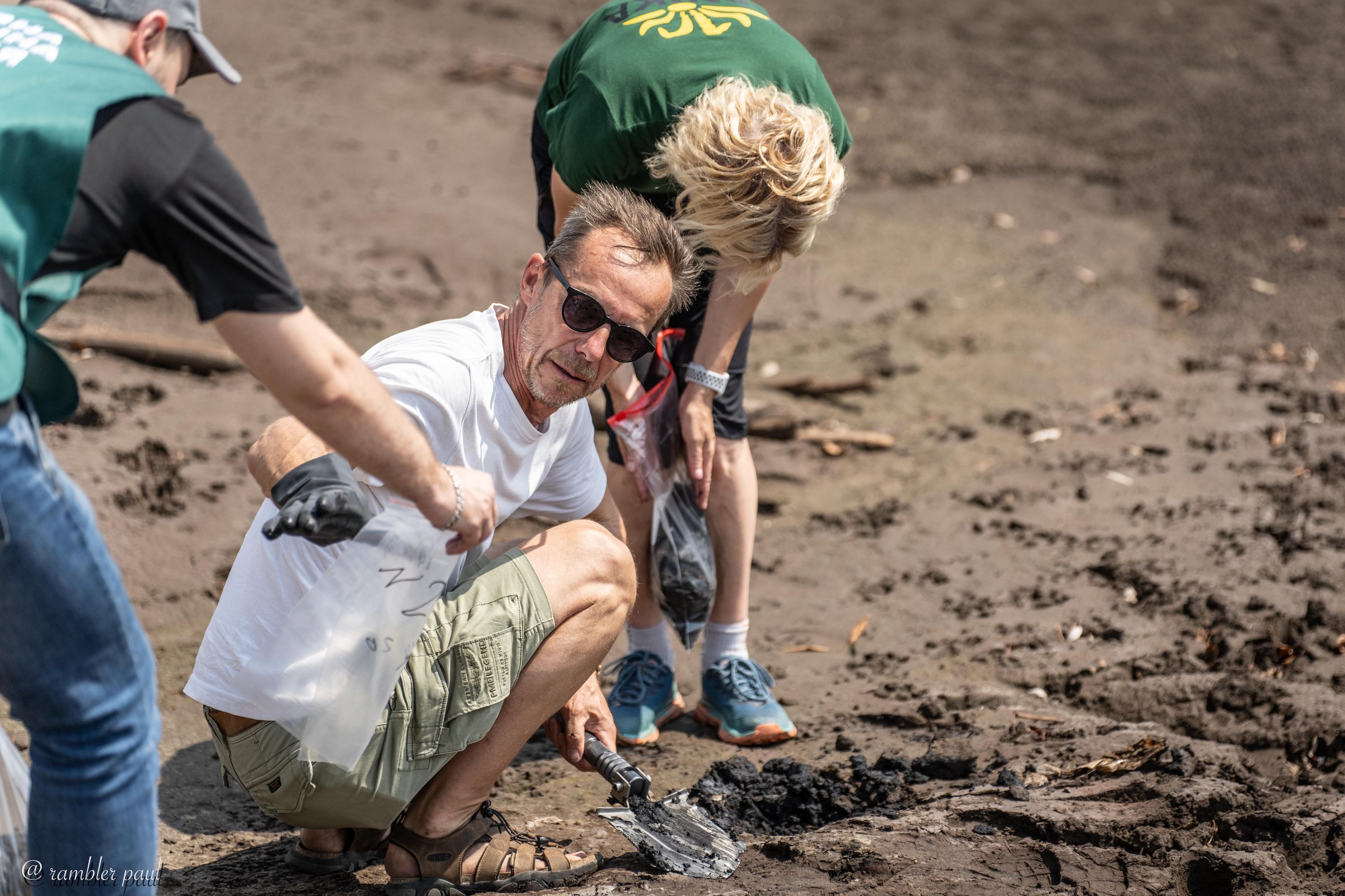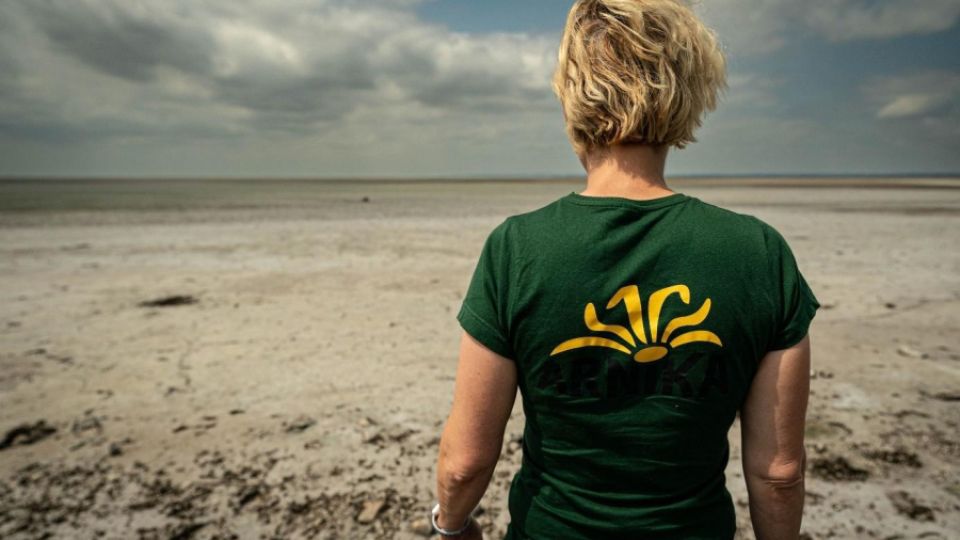ZAPORIZHZHIA / PRAGUE - The destruction of the Kakhovka dam in 2023 not only caused widespread immediate disaster, but also exposed sediments full of toxic chemicals that had been deposited there for decades. These are found even in such exposed places as the public beach, including highly dangerous substances such as the old pesticide DDT. These are the results of a comprehensive analysis carried out in cooperation of Ukrainian civil society organisations, the Czech NGO Arnika and the company Dekonta.
The researchers analysed fourteen samples: eleven from sediments of the former reservoir, two soil samples from the impact craters of a Russian S-300 system rockets, and one soil sample from the industrial district in Zaporizhzhia. The samples were collected in two rounds and tested for a wide range of contaminants, including pesticides, heavy metals, petroleum hydrocarbons, or so-called forever chemicals, PFAS.1
“Probably the most serious finding is the alarming level of the highly dangerous, long banned pesticide DDT, 2 accompanied by relatively lower levels of another harmful insecticide, HCH. These were found in sediment samples from the central city beach in Zaporizhzhia, a place regularly used by the local population for recreation,” sums up Nikola Jelínek, Arnika’s expert on toxic substances in the environment.
The study warns that the concentrations of DDT and HCH in sediments are indicating a proximity of a site heavily contaminated with these pesticides, such as an obsolete pesticide dump, emphasising the need to identify a specific source. However, one possible explanation is also a long-term accumulation of contaminants in the sediment of the former reservoir during the years of intensive use in Soviet agriculture.
READ THE WHOLE STUDY HERE
“This is, of course, a very warning signal, especially considering that the sample was taken from a site dedicated for public use, not an industrialized area. The pesticides in question would be highly dangerous if they entered the food chain, not to mention a whole host of other harmful substances from that we found here,” says Olexiy Angurets, expert on ecology and sustainable development of the Clean Air for Ukraine campaign – a long-lasting partnership of the Ukrainian non-governmental organizations and Arnika.
The study compared the measured levels of each substance with the levels used in the Czech Ministry of the Environment's methodology to determine the suitability of the site for decontamination. In some cases, these levels were exceeded many times over - including again at the public beach in Zaporizhzhia. Here, levels of the potent carcinogen and mutagen benzo(a)pyrene were found to be more than 2,300 times above the limit. At the same time, experts found significant petroleum hydrocarbons contamination, probably related to heavy or chemical industry.
Unfortunately, this was not the only heavily polluted site. The study also highlights the industrial pollution of sediments from the confluence of the Sukha Moskovka stream with the Dnipro River. The area is heavily contaminated with heavy metals, especially arsenic, manganese and chromium, but also with polychlorinated biphenyls (PCBs).3 "This may be due to historical contamination or industrial sources. The high concentrations of other substances suggest that the source could be heavy industry, whether metallurgical or engineering," the study explains, noting that the Sukha Moskovka stream passes close to several heavy industries in Zaporizhzhia.
Some potentially hazardous substances were present in most of the samples taken. For example, chromium exceeded the Czech decontamination guideline in all samples. Arsenic was found in relevant concentrations in ten of the fourteen samples. Experts point out that the legacy of environmental pollution is dangerous in itself, but the war is making it much worse.
"That the aftermath of Russia's aggression against Ukraine is having serious environmental consequences, bordering on ecocide, has unfortunately been more than obvious for some time. But here we can also see how the war has created half-forgotten chemical hazards and a permanent chemical burden that will be difficult to remove. We need to talk not only about options for future decontamination of the affected sites, but also about post-war reconstruction perspectives that are environmentally sustainable and prioritise the protection of public health," comments Marcela Černochová, Arnika's project coordinator in Ukraine.
 Sediment sampling in 2023; Photo Pavel Mothejl
Sediment sampling in 2023; Photo Pavel Mothejl
The destruction of the Kakhovka dam on 6 June 2023 was one of the most striking examples of environmental damage caused by the Russian invasion to Ukraine. The breach caused a widespread flooding of vast areas of farmland and dozens of settlements, with thousands of people evacuated and at the very least 32 killed. The area of the former reservoir itself has been largely drained and is rapidly becoming vegetated with wild plants. But there are many other cases of ecological destruction, such as the recent poisoning of the Desna River with industrial chemicals, which the Ukrainian authorities blame on a deliberate Russian act.
The currently published study is one of the results of a long-term collaboration between the Czech NGO Arnika and its Ukrainian partners Free Arduino (Ivano-Frankivsk) and Green World (Dnipro). Their activities have taken place in different parts of Ukraine since 2017, focusing mainly on regulating industrial air pollution and raising public awareness through the Clean Air for Ukraine programme. Since the full-scale Russian invasion in 2022, environmentalists have focused on the imminent environmental damage caused by the war, trying both to protect the population from new threats and to outline the possibilities of a sustainable, public health-friendly post-war recovery.
The research was financed by the Transition Promotion Program of the Ministry of the Foreign Affairs of the Czech Republic and the Government of Sweden.

Annexes
For more information, please visit the website of the Clean Air for Ukraine project: https://cleanair.org.ua/
[1] - Both sampling stages were performed in 2023. Seven of eleven sediment samples were taken from the river Dnipro (one of them from Dnipro River in Kherson), three from Kakhovka reservoir, two soil samples from craters after explosions of missiles were taken in Zaporizhzhia city and one more soil sample from industrial district in Zaporizhzhia. Specialized laboratories then analysed contents of: heavy metals, polycyclic aromatic hydrocarbons (PAHs), non-polar extractable compounds (NECs), hydrocarbons C10 – C40, cyanides, polychlorinated biphenyls (PCBs), hexachlorobenzene (HCB), pentachlorobenzene (PeCB), hexachlorobutadiene (HCBD), organochlorine pesticide residues (OCPs), brominated flame retardants (BFRs), dechlorane plus (DP), polychlorinated naphthalenes (PCNs), poly- and perfluoroalkylated substances (PFASs), short and medium chain chlorinated paraffins (SCCPs and MCCPs) and dioxins (PCDD/Fs) and dioxin-like PCBs (dl PCBs) by DR CALUX bioassay. In the second stage of sampling – NECs, cyanides, silver, PCDD/Fs and dl PCBs by DR CALUX bioassays were not analysed.
[2] - DDT (dichlorodiphenyltrichloroethane) and its various related compounds were once an influential insecticide, widely used in agriculture and for the control of vector-borne diseases such as malaria. However, its serious effects on the neurological, reproductive, immunological and hepatic systems of humans and the reproduction of birds, for example, and its tendency to accumulate in the soil for decades (and/or to break down into substances as toxic as the original pesticide) have led to its use being severely restricted. High levels of DDT are still found in the vicinity of DDT production sites, obsolete pesticide stockpiles and dump sites - particularly in post-Soviet countries, including Ukraine.
[3] - PCBs are highly toxic, carcinogenic industrial compounds used in the past, until internationally banned in 2001 by the Stockholm convention on persistent organic pollutants. These substances are highly durable and can last in place for many decades, threating both people and animals with a wide variety of health impacts especially when entering their food chain.








